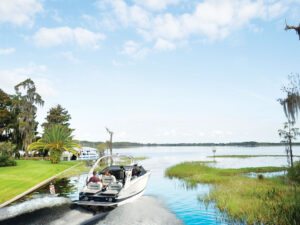VIVA ZAPATA
I’ve never had a guide hug me before. Then again, I’d never been backcountry fishing in Cuba, either. We were in a swampy national park on the Zapata Peninsula, cruising down the Rio Hatiguanico, a pristine tidal river dense with mangroves. In our 12′ skiffs powered by 10-hp Yamahas, we sought out sabalo. In English, that’s tarpon.
This area also offers some of the best flats fishing in the Caribbean. At the Laguna de las Salinas, anglers typically catch as many as 40 bonefish in a day – all less than two hours south of Havana.
Our guide, Osmany Gonzalez (059-7249), is an ornithologist – he named every exotic bird we flushed. His keen eyes also spotted boils along the mangroves, pointing them out almost every hundred yards. I used my 9-weight fly rod to cast out yellow and white streamer flies. Senior Editor David Seidman cast a plastic baitfish imitation on a spinning rig. We couldn’t buy a bite.
Then the rain came. We rammed the boats into a mangrove canopy for cover, cut an empty beer can in half, and pulled out a bottle of rum to fill it. “In Cuba we drink rum for breakfast, rum for lunch, rum for dinner,” Gonzalez said, handing me the can.
The rain stopped and Gonzalez quickly pushed back into the river. “The time is now, my friend,” he said. The water erupted. We could see hundreds of tarpon moving down both banks. It was all I could do to breathe. I cast in front of the pack and stripped. A 12-pound baby nailed my fly and launched into some serious aerial acrobatics. He jumped six times. Seidman hooked one that jumped only once – into his skiff. “My friend,” Gonzalez repeated as he leaned over to embrace me, “the time is now.”
BEISBOL
The stadium was too hard to find, so we gave a guy on a bicycle dos cervezas to lead us to the 39th Annual Cuban Baseball Series – Santiago vs. Pinar del Rio. It was Game Three, and we were there because, outside of boating and fishing, baseball is one of the best pastimes in the world.
We bagged great seats on the third baseline. We saw people wearing hats from the Yankees, Braves, Indians, and Marlins. But not much else was familiar. The stadium walls were bereft of advertising but carried such slogans as “No obesity and sedentariness.” Instead of hot dogs and beer, vendors sold ham sandwiches and pineapple juice in paper cones. When Pinar del Rio came to bat, a mad group playing congas, cowbells, and horns whipped the stadium into a frenzy. It was lot more intense than doing the wave.
On the field, players shook the umpire’s hand at home plate. Bats and helmets were communal equipment. The game was exceptional. Pinar del Rio’s Omar Linares, the world’s best amateur player, twice ripped long doubles, sending the conga players to euphoric heights. We joined right in, screaming and exchanging high-fives with the fans. (They thought we were scouts for the Yankees.) Alas, Santiago took a 6-2 lead, won the game, and swept the series the next night. All in all, though, Cuban beisbol was very, very good to us.









